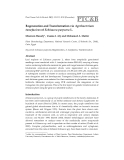
Genetic and molecular
-
Objectives of the thesis: Identifying genetic diversity and basic genetic parameters as a basis for creating a high-quality genetic variation of tiger shrimp for initial breeding of tiger shrimp according to growth traits.
 25p
25p  tunelove
tunelove
 11-06-2021
11-06-2021
 15
15
 3
3
 Download
Download
-
Evaluate genetic diversity of Lien Minh chickens based on sequences of mitochondrial DNA D-loop region; determine the genetic relationship and the origin of Lien Minh chickens; identif genetic relationships between candidate genes and egg yield traits in Lien Minh chickens.
 27p
27p  kequaidan7
kequaidan7
 01-09-2020
01-09-2020
 32
32
 3
3
 Download
Download
-
Understanding the genetic complexity of traits is an important objective of small grain temperate cereals yield and adaptation improvements. Bi-parental quantitative trait loci (QTL) linkage mapping is a powerful method to identify genetic regions that co-segregate in the trait of interest within the research population. However, recently, association or linkage disequilibrium (LD) mapping using a genome-wide association study (GWAS) became an approach for unraveling the molecular genetic basis underlying the natural phenotypic variation.
 17p
17p  partimesinhvien
partimesinhvien
 08-05-2020
08-05-2020
 17
17
 1
1
 Download
Download
-
Research objectives: Thesis was the first studied methodically systematic assessment of genetic diversity by morphological indicators combined with molecular markers, identification of Vietnamese native Dendroium species based on the ITS sequences. The results of the thesis have significance in the classification, the conservation service, and selection and breed new varieties; these will be contributing to improve Vietnam orchids.
 27p
27p  change03
change03
 06-05-2016
06-05-2016
 74
74
 6
6
 Download
Download
-
The design of b-glycosidases with planed substrate specificity for biotechnological application has received little attention. This is mostly a consequence of the lack of data on the molecular basis of the b-glycosidase specificity, namely data on the energy of the noncovalent interactions in the enzymetransition state complex. In an attempt to fill this gap, sitedirected mutagenesis and enzyme steady-state kinetic experiments with different substrates were conducted, using as model a digestive b-glycosidase (glycoside hydrolase family 1) from Spodoptera frugiperda (Lepidoptera) (Sfbgly50).
 10p
10p  system191
system191
 01-06-2013
01-06-2013
 41
41
 4
4
 Download
Download
-
A recombinant lipase cloned from Pseudomonas fragi strain IFO 3458 (PFL) was found to retain significant activity at low temperature. In an attempt to elucidate the structural basis of this behaviour, a model of its three-dimensional structure was built by homology and compared with homologous mesophilic lipases, i.e. the Pseudomonas aeruginosa lipase (45% sequence identity) and Burkholderia cepacia lipase (38%).
 8p
8p  system191
system191
 01-06-2013
01-06-2013
 48
48
 4
4
 Download
Download
-
The case of homologous monomeric c-type and oligomeric b-type crystallins has been described and analyzed in evolutionary terms. Data and hypotheses from molecular genetics and structural investigations converge and suggest a novel three-phase model for the evolutionary history of crystallin-type proteins. In the divergent cascades of monomeric and oligomeric crystallins, a pivotal role was played by alterations in the gene segments encoding the C-terminal extensions and the intermotif or interdomain linker peptides.
 9p
9p  system191
system191
 01-06-2013
01-06-2013
 41
41
 4
4
 Download
Download
-
SHP-1, a protein-tyrosine phosphatase with two srchomology 2 domains, is expressed predominantly in hematopoietic and epithelial cells and has been implicated in numerous signaling pathways as a negative regulator. Two promoters direct the expression of human and murine SHP-1, and two types of transcripts (I) and (II) SHP-1, are initiated from each of these promoters. The cDNA sequences of (I)SHP-1 and (II)SHP-1 are identical except in the 5¢ untranslated region and in the first few coding nucleotides.
 8p
8p  system191
system191
 01-06-2013
01-06-2013
 36
36
 3
3
 Download
Download
-
Introducing site-directed mutations in surface-exposed residues of subunit II of the heme aa3 cytochrome c oxidase of Paracoccus denitrificans, we analyze the kinetic parameters of electron transfer from reduced horse heart cytochrome c. Specifically we address the following issues: (a) which residues on oxidase contribute to the docking site for cytochrome c, (b) is an aromatic side chain required for electron entry from cytochrome c, and (c) what is the molecular basis for the previously observed biphasic reaction kinetics....
 9p
9p  system191
system191
 01-06-2013
01-06-2013
 36
36
 3
3
 Download
Download
-
Subunits (a, b and c) of the interleukin-2 receptor complex (IL-2R) are involved in both proliferative and activationinduced cell death (AICD) signaling of T cells. In addition, the signaling b and c chains are shared by other cytokines (e.g. IL-7, IL-9, IL-15). However, the molecular mechanisms responsible for recruiting/sorting the a chains to the signaling chains at the cell surface are not clear.
 10p
10p  research12
research12
 01-06-2013
01-06-2013
 29
29
 5
5
 Download
Download
-
Murine double minute 2 (MDM2) protein exhibits many diverse biochemi-cal functions on the tumour suppressor protein p53, including transcrip-tional suppression and E3 ubiquitin ligase activity. However, more recent data have shown that MDM2 can exhibit ATP-dependent molecular chap-erone activity and directly mediate folding of the p53 tetramer. Analysing the ATP-dependent function of MDM2 will provide novel insights into the evolution and function of the protein.
 12p
12p  research12
research12
 29-04-2013
29-04-2013
 61
61
 4
4
 Download
Download
-
Tripeptidyl-peptidase II (TPP II) is a large (Mr106 ) tripeptide-releasing enzyme with an active site of the subtil-isin-type. Compared with other subtilases, TPP II has a 200 amino-acid insertion between the catalytic Asp44 and His264 residues, and is active as anoligomeric complex. This study demonstrates that the insert is important for the formation of the active high-molecular mass complex.
 6p
6p  research12
research12
 29-04-2013
29-04-2013
 37
37
 3
3
 Download
Download
-
Leaf explants of Echinacea purpurea L. taken from aseptically germinated seedlings were inoculated with A. tumefaciens strains EHA105, carrying a binary vector conferring herbicide resistant bar gene and fungal resistant chitinase gene. Glufosinate ammonium‐resistant shoots were regenerated on a medium containing BAP and NAA at a concentration of 4.88 and 0.053 μM, respectively. A subsequent transfer of shoots to medium containing BAP was necessary for stem elongation and leaf development.
 11p
11p  zingzing09
zingzing09
 24-04-2013
24-04-2013
 35
35
 2
2
 Download
Download
-
The envelope protein gp64 of the baculovirusAutographa californicanuclear polyhedrosis virus is essential for viral entry into insect cells, as the glycoprotein bothmediates pH-dependentmembrane fusionandbinds tohost cell receptors. Surface modification of baculovirus particles by genetic engineering of gp64 has been demonstrated by various strategies and thus has become an important and powerful tool in molecular biology.
 10p
10p  research12
research12
 23-04-2013
23-04-2013
 27
27
 2
2
 Download
Download
-
A sialylated lacto-N-neotetraose (Sial-lNnT) structural unit was identified and structurally characterized in the lipo-polysaccharide (LPS) from the genome-sequenced strain Road (RM118) of the human pathogenHaemophilus influ-enzaegrown in the presence of sialic acid. A combination of molecular genetics, MS and NMR spectroscopy techniques showed that this structural unit extended from the proximal heptose residue of the inner core regionof theLPSmolecule.
 11p
11p  research12
research12
 23-04-2013
23-04-2013
 36
36
 2
2
 Download
Download
-
Serotonin transporters are key target sites for clinical drugs and psychostimulants, such as fluoxetine and cocaine. Molecular cloning of a serotonin transporter from the cen-tral nervous system of the insectManduca sextaenabled us to define domains that affect antagonist action, particularly cocaine.
 11p
11p  research12
research12
 23-04-2013
23-04-2013
 35
35
 1
1
 Download
Download
-
Lipopolysaccharide (LPS) ofEscherichia colistrain2513 (R4 core-type) yielded after alkaline deacylation one major oligosaccharide by high-performance anion-exchange chro-matography (HPAEC) which had a molecular mass of 2486.59 Da as determined by electrospray ionization mass spectrometry. This was in accordance with the calculated molecular mass of a tetraphosphorylated dodecasaccharide of the composition shown below.
 10p
10p  tumor12
tumor12
 22-04-2013
22-04-2013
 38
38
 3
3
 Download
Download
-
Upon mutation of Asp153 by asparagine, the catalytic activity of agmatinase (agmatine ureohydrolase, EC 3.5.3.11)fromEscherichia coliwas reduced to about 5% of wild-type activity. Tryptophan emission fluorescence (kmax ¼340 nm), and CD spectra were nearly identical for wild-type and D153N agmatinases. TheKmvalue for agmatine (1.6 ± 0.1 mM),aswellastheKi for putrescine inhibition (12 ± 2 mM)and the interaction of the enzyme with the requiredmetal ion,werealsonot alteredbymutation.
 5p
5p  tumor12
tumor12
 22-04-2013
22-04-2013
 22
22
 3
3
 Download
Download
-
The ethanol utilization pathway inAspergillus nidulansis a model system, which has been thoroughly elucidated at the biochemical, genetic and molecular levels. Three main ele-ments are involved: (a) high level expression of the positively autoregulated activator AlcR; (b) the strong promoters of the structural genes for alcohol dehydrogenase (alcA)and aldehyde dehydrogenase (aldA); and (c) powerful activa-tion of AlcRby the physiological inducer, acetaldehyde, produced from growth substrates such as ethanol and L-threonine. ...
 10p
10p  tumor12
tumor12
 20-04-2013
20-04-2013
 21
21
 2
2
 Download
Download
-
The cell line, RCS-LTC (derived from the Swarm rat chondrosarcoma), deposits a copious extracellular matrix in which the collagen component is primarily a polymer of partially processed type II N-procollagen molecules. Transmission electron microscopy of the matrix shows no obvious fibrils, only a mass of thin unbanded filaments. We have used this cell system to show that the type II N-pro-collagen polymer nevertheless is stabilized by pyridinoline cross-links at molecular sites (mediated by N- and C-telo-peptide domains) found in collagen II fibrils processed nor-mally....
 8p
8p  tumor12
tumor12
 20-04-2013
20-04-2013
 29
29
 1
1
 Download
Download
CHỦ ĐỀ BẠN MUỐN TÌM
































